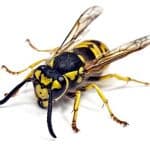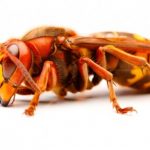Votre panier est actuellement vide !

The hornet
The hornet is the largest species of the wasp family but the largest individuals here never exceed 28 mm, and only the queen can be larger at 35 mm. It also has longer wings and its body seems to be covered with small hairs.it has a stinger to inject poison but it is said to be more terrible than it really is.
Latin Name: Vespa crabro
Description :
The majority of the species of hornets is found in Asia or in the hot countries, but one finds some species in Quebec.
The hornet is the largest species of the wasp family but the largest individuals here never exceed 28mm, and only the queen can be larger at 35mm.
It looks like the common yellow wasp but has a rounder thorax and is mostly black with traces of yellow. It also has longer wings.
Its body seems to be covered with small hairs.
It has a stinger to inject poison but it is said to be more terrible than it really is.
The tradition that says the hornet gives a terribly painful sting is in fact false since its venom is less powerful than that of the bee. On the other hand, like the yellowjacket, it does not lose its stinger when it stings and can sting the same prey several times.
They are great insect hunters and are much more useful than harmful.
As a rule they are peaceful and if you don’t interrupt their flight or make sudden movements or loud noises next to them, they will leave you alone.
You still have to be careful because they will defend their nest if you come within two or three meters of it.
Reproduction:
In the spring, the fertilized queen, who had spent the winter in the ground or a tree crack, comes out of her hibernation and goes in search of a place to install a new nest.
It usually seeks out a sheltered spot such as a hole in a tree or ledges or barn roofs.
When she finds the right place she builds a small stalk well hung on which she will build about fifty cells. She will lay eggs in them and 5 to 8 days later, the first larvae will appear.
During the next 12-15 days the queen will feed them while they weave a cocoon to go through their 5 larval stages.
When the first 8 or 10 workers emerge from their cocoon, they take 2 or 3 days to fly away and the construction of the nest begins.
They fetch wood to build a paper mache nest with their saliva and the work is done even at night.
At the same time the colony grows and when the nest includes about thirty individuals (at the beginning of the summer) it reaches its limit and the colony moves to build a larger nest.
Towards the end of August, the nest is at maximum capacity and can contain 400 to 700 individuals and the nest can be up to 60 cm high.
By mid-September, the queen has laid new sexed females and males and the workers stop feeding her to take care of the new « royal » children. During the following months the queen will die, the young queens will fly away, be impregnated by the males and go and find a well insulated hiding place to spend the winter.
Habits:
Hornets are the birds of prey of the insect world, the workers hunt insects day and night to bring pellets of « meat » back to the nest to feed the queen and the larvae.
A rather important colony must receive about half a kilo of insects per day to feed itself, which represents the daily consumption of 5 or 6 families of titmice.
The workers feed exclusively on sweet juice and tree sap.
That’s why we see hornets on very ripe fruit that has fallen to the ground in orchards.
They are given a bad reputation as bee destroyers but in fact, even if they manage to capture bees for food, they do not kill more than 1% of the swarm and the number of deaths by pesticide or motor vehicle is much higher.
Prevention:
Hornets are much more peaceful than yellow jackets and will only get upset if their nest is threatened.
Also, unlike yellow wasps, they are not at all interested in the sugar found on the human menu so you won’t see them hanging around your table.
If you are stung by a hornet, suck on the sting and cool it down and the pain will disappear almost immediately. Allergic reactions only occur in 2-3% of cases.
Naturally, if the person has been stung several times, a doctor should be consulted quickly.
It is not suggested that you attempt to remove a hornet’s nest on your own as they can become very aggressive when their nest is threatened. Special equipment is required, especially if the nest is located inside a structure (roof, wall, ceiling etc.).
Don’t take unnecessary risks, call in the experts.
